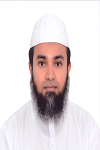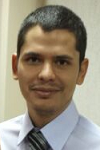Day 2 :
Keynote Forum
Jongweon Kim
Sangmyung University, Korea
Keynote: Security issues for multimedia content
Time : 10:05-10:35

Biography:
Jongweon Kim received his PhD degree from University of Seoul, major in signal processing. He is currently a Professor of Department of Contents and Copyright and Chief of Creative Content Labs at Sangmyung University in Korea. He has a lot of practical experiences in the digital signal processing and copyright protection technology in the institutional, the industrial, and academic environments. His research interests are in the areas of copyright protection technology, digital rights management, digital watermarking, and digital forensic marking.
Abstract:
Advance of internet and computer technology allowed people to have access to multimedia easily. However, on the other side of this advantage, infringement has risen up as a problem. Although each country has been taking copyright laws to restrict the infringement, different laws of countries have created a gap between countries protected the laws well and those could not. Recently nations of pan pacific are promoting a commitment to strengthen the copyright. Despite all the efforts, piracy is still increasing. Improvement of law along with the development of the technology is not compromised. Especially emerging of new technologies such as Torrent required efficient copyright protection measure. This presentation is going to deal with typical copyright protection measure such as digital right menagement, watermarking, and digital finger printing as well as the controversies of each technologies.
Keynote Forum
Tsang-Ling Sheu
National Sun Yat-Sen University, Taiwan
Keynote: Emerging technologies for multimedia networks
Time : 10:35-11:05

Biography:
Tsang-Ling Sheu has received his PhD degree in Computer Engineering from the Department of Electrical and Computer Engineering, Penn State University, University Park, Pennsylvania, USA in 1989. He has worked with IBM Corporation at Research Triangle Park, North Carolina, USA (1989-1995). In 1995, he became an Associate Professor and was promoted to Full Professor in 2006 at the Department of Electrical Engineering, National Sun Yat-Sen University, Taiwan. His research interests include wireless networks, mobile communications and multimedia networking. He was the recipient of the 1990 IBM outstanding paper award and he is a Senior Member of the IEEE and the IEEE Communications Society.
Abstract:
There is a growing need for people to communicate with each other and have timely access to multimedia regardless of the location of the individuals or the information. Emerging technologies for multimedia networks (ETMN) pose an engineering challenge that can be met only with an efficient and reliable network. The demand for multimedia networks is increasing and its sophistication and ubiquity has led to the need for a better understanding of fundamental issues. The workshop of ETMN intends to provide a forum for researchers, educators and professionals to exchange their discoveries and practices and to explore future trends and applications. Your presentation at the workshops would be an excellent opportunity for you to meet colleagues and to discuss technology advancements. Possible topics of interests include but are not limited to Multimedia Protocols and Architectures, Multimedia on Mobile Communication Systems (4G/5G), Multimedia on MTM, Ad-hoc and Sensor Networks, Multimedia Vehicular Networks, Multimedia Network Performance, Analysis and Evaluation, Quality of Services (QoS) and Innovative Multimedia Networking and Applications.
- Multimedia Search and Retrieval
Multimedia Systems and Applications
Music, Speech and Audio Processing in Multimedia
Multimedia Networking
Advances in Multimedia Technology
Location: Salis-Well

Chair
Mohamed Abdur Rahman
Umm Al-Qura University, KSA

Co-Chair
Alex Lopes Pereira
Technological Institute of Aeronautics, Brazil
Session Introduction
Duraid Y. Mohammed
University of Salford, UK
Title: Audio Content Analysis in The Presence of Overlapped Classes - A Non-Exclusive Segmentation Approach to Mitigate Information Losses
Time : 11:25-11:50

Biography:
Duraid Y. Mohammed is a 2nd year Ph.D student at university of Salford/ School of Computing, Science and Engineering/ Acoustics research center. He has published 1 conference paper in Audio Engineering Society (AES) 136th and his second paper is accepted for published in IEEE journal.
Abstract:
Soundtracks of multimedia files are information rich, from which much content-related metadata can be extracted. There is a pressing demand for automated classification, identification and information mining of audio content. A segment of the audio soundtrack can be either speech, music, event sounds or a combination of them.There exist many individual algorithms for the recognition and analysis of speech, music or event sounds, allowing for embedded information to be retrieved in a semantic fashion. A systematic review shows that a universal system that is optimized to extract the maximum amount of information for further text mining and inference does not exist. Mainstream algorithms typically work with a single class of sound, e.g. speech, music or even sounds and classification methods are predominantly exclusive (detects one class at a time) and losing much of information when two or three classes are overlapped. A universal open architecture for audio content and scene analysis has been proposed by the authors. To mitigate information losses in overlapped content, non-exclusive segmentation approaches were adopted. This paper is presented from one possible implementation deploying the universal open architecture as a paradigm to show how the universal open architecture can integrate existing methods and workflow but maximize ex-tractable semantic information.In the current work, overlapped content is identified and segmented from carefully tailored feature spaces and a family of decision trees are used to generate a content score. Results show that the developed system, when compared with well established audio content analyzers, can identify and thus extract information from much more speech and music segments. The full paper will discuss the methods, detail the results and illustrate how the system works.
Panagiotis Petridis
Aston University, UK
Title: Transforming the adoption of product-service systems through innovations in applied gaming technologies
Time : 11:50-12:15

Biography:
Panagiotis Petridis is a senior Lecturer in Gamification at Aston Univerisity. He has spent his entire career working in the field of virtual reality, simulation and gaming. His interest is in how these technologies can be used to change people’s behaviours, to help them make decisions and learn about things through realistic simulated experiences. He has published more than 60 papers in reputed journals and conferences. He has worked on and managed a large number of funded research projects developing virtual realities for use across a range of industries such as cultural heritage, construction, manufacturing and housing.
Abstract:
Adding value to manufacturing through services or “servitization” is now one of the central pillars of the Government’s economic policy. Modern manufacturing is now seen as extending well beyond mere production, and that Product-Service Systems (PSS) are key to industrial success. Servitization concerns the process of manufacturers shifting from a focus on producing and selling tangible goods to service-based business models. Factors that drive adoption of servitization are financial, strategic (competitive advantage) and marketing. However, uptake is slow and active efforts are being made to transfer knowledge about servitization to the manufacturing sector. Serious games and gamification can provide a tools to transfer the knowledge of servitization to the manufacturing section. The use of digital games and gamification has demonstrable potential to improve many aspects of how businesses provide training to staff, operate, and communicate with consumers. However, a need still exists for the benefits and potential of adopting games and gamification be effectively communicated to decision-makers across sectors. This presentation provides a structured review of existing literature on the use of games in the business sector, seeking to consolidate findings to address research questions regarding their perception, proven efficacy, and identify key areas for future work. The findings consolidate evidence showing serious games can have a positive and valuable impact in multiple areas of a business, including training, decision-support, and consumer outreach. They also highlight the challenges and pitfalls of applying serious games and gamification principles within a business context, and discuss the implications of development and evaluation methodologies on the success of a game-based solution.
Tsang-Ling Sheu
National Sun Yat-Sen University, Taiwan
Title: An ARQ retransmission scheme for real-time video multicasting over mobile communication networks
Time : 12:15-12:40

Biography:
Tsang-Ling Sheu received the PhD degree in Computer Engineering from the Department of Electrical and Computer Engineering, Penn State University, University Park, Pennsylvania, USA, in 1989. From Sept. 1989 to July 1995, he worked with IBM Corporation at Research Triangle Park, North Carolina, USA. In Aug. 1995, he became an Associate Professor, and was promoted to full Professor in Jan. 2006 at the Dept. of Electrical Engineering, National Sun Yat-Sen University, Kaohsiung, Taiwan. His research interests include wireless networks, mobile communications, and multimedia networking. He was the recipient of the 1990 IBM outstanding paper award. He is a senior member of the IEEE, and the IEEE Communications Society.
Abstract:
Multicast is an effective mechanism to substantially save network bandwidth while transmitting real-time video streams in a wireless mobile communication network (such as 3G/4G). However, today it lacks of a packet retransmission scheme for real-time video multicasting in mobile communication networks. The last hop of a mobile communication network is defined as the hop between a base station (BS)/gateway and a mobile station (MS). Packet errors happen very easily in the last hop because wireless channels in a mobile communication network are error-prone. As a result, packet errors in the last hop may bring a critical deterioration of video quality at MS. Besides, an end-to-end retransmission scheme, such as TCP, cannot meet the strict delay constraints of a real-time video stream. Hence, in this paper, we propose a retransmission scheme to improve the quality of video multicasting in the last-hop of a mobile communication network. The proposed retransmission scheme requires MS in a multicast group to feedback ARQ (Automatic Repeated Request) messages to BS/Gateway. The proposed retransmission scheme is invoked under three considerations: the extra bandwidth cost for retransmitting the erroneous blocks, the retransmission delay, and the acceptable delay constraints at MS. NS-3 simulation is performed to demonstrate the superiority of the proposed retransmission scheme. From simulation, we reveal how well the retransmission scheme can reconstruct the quality of a multicast video stream at MS. Furthermore, the extra bandwidth cost for retransmitting erroneous blocks is investigated.
Zi-Tsan Chou
National Sun Yat-Sen University, Taiwan
Title: An opportunistic cooperative MAC protocol for cognitive vehicular networks
Time : 13:30-13:55

Biography:
Zi-Tsan Chou received the PhD degree in computer science and information engineering from National Taiwan University, Taipei, Taiwan, in 2003. He is currently an associate professor at the Department of Electrical Engineering, National Sun Yat-Sen University, Kaohsiung, Taiwan. His industrial experience includes NEC Research Institute, America, and the Institute for Information Industry, Taiwan. His research interests include medium access control, power management, and quality-of-service control for wireless networks. He is a member of both the IEEE and the IEEE Communications Society.
Abstract:
In this paper, we can consider an application scenario in cognitive vehicular networks: Under the condition that different vehicles in different locations may have different set of available licensed channels, how do the vehicles (called potential relays) that correctly received data from the gateway choose the proper channel to concurrently relay the data to the vehicles (called potential destinations) that did not receive data from the gateway such that the network throughput can be maximized. We call this problem the interference-free multi-channel poly-matching (IMP) problem. To the best of our knowledge, this paper is the first one to seriously address this issue. The contributions of this paper are three-fold: (i) We use the integer mathematical programming to formally model the IMP problem, which is NP-complete. (2) We design a simple centralized greedy algorithm to efficiently solve this problem. (3) On the basis of our centralized greedy algorithm, we design a novel distributed medium access control protocol, named opportunistic cooperative MAC (OC-MAC for short), such that only via local information exchange between vehicles, the number of potential destinations that finally receive data from potential relays can be maximized. Simulation results show that the throughput of OC-MAC is approximately equal to that of centralized greedy algorithm and is greatly higher than that of Random MAC.
Mohamed Abdur Rahman
Umm Al-Qura University, Kingdom of Saudi Arabia
Title: Multimedia Big Data Environment for e-Therapy
Time : 13:55-14:20

Biography:
Md Abdur Rahman is an A/Professor in the Department of Computer Science of Umm Al-Qura University, Makkah Al Mukarramah, KSA. Dr. Abdur Rahman received his Ph. D. degree in electrical and computer engineering from the University of Ottawa, Canada. His research interests include serious games, spatio-temporal databases, multimedia for e-Learning, multimedia for healthcare, Ambient assisted living, and context-aware multimedia systems. He has authored and co-authored more than 75 publications including refereed IEEE/ACM/Springer journals, conference papers, and book chapters. Dr. Abdur Rahman is a Member of IEEE and a member of ACM.
Abstract:
Due to the low cost and high availability of wearable health sensors and motion tracking devices, home based therapy monitoring has come to a reality. In this paper, we propose a gesture controlled e-therapy online framework that can monitor physical and occupational therapy exercises using multimedia data produced by different sensors such as Kinect2, Leap, and Myo. The multimedia therapeutic data is then stored in a big data repository with proper annotation. We have developed analytics to mine therapeutic information from the big data platform such as finding the most appropriate therapy regime for a patient based on her age, ethnicity, gender, disability level and geo-spatial location. We will show different key queries that can be answered by our developed analytics.
Alex Lopes Pereira
Technological Institute of Aeronautics, Sao Jose dos Campos, Brazil
Title: Patch-based local histograms and contour estimation for static foreground classification
Time : 14:20-14:45

Biography:
Alex Pereira is a Computer Engineer who started his career as a tech entrepreneur. He co-founded a company (www.monity.com.br) that developed technology for video surveillance just after obtaining his undergraduate degree from the Brazilian Technological Institute of Aeronautics. Currently Alex works in research and development at the Brazilian Ministry of Defense. Alex received his Master's Degree in Electronic and Computer Engineering in 2008 and received his Doctor of Science degree in 2015. His main research interest are Image and Video Processing, Embedded Systems, Linux and Machine Learning
Abstract:
This speech is about an approach to classify static foreground blobs in surveillance scenarios. Possible application is the detection of abandoned and removed objects. In order to classify the blobs we developed two novel features based on the assumption that the neighborhood of a removed object is fairly continuous. In other words, there is a continuity, in the input frame, ranging from inside the corresponding blob contour to its surrounding region. Conversely, it is usual to find a discontinuity, i.e. edges, surrounding an abandoned object. We combined he two features to provide a reliable classification. In the first feature, we use several local histograms as a measure of similarity instead of previous attempts that used a single one. In the second, we developed an innovative method to quantify the ratio of the blob contour that corresponds to actual edges in the input image. A representative set of experiments shows that the proposed approach can outperform other equivalent techniques published recently.
Kuang-Hui Chi
National Yunlin University of Science and Technology, Taiwan
Title: Inhomogeneous wireless network load distribution
Time : 14:45-15:10

Biography:
Kuang-Hui Chi is Associate Professor at the Department of Electrical Engineering, National Yunlin University of Science and Technology, Taiwan. His current research interest lies in Wireless Internet.
Abstract:
Network inhomogeneity appears common as devices of different capabilities were phased in over time. As a result, households and enterprises may deploy IEEE 802.11n access points (APs) with joint use of earlier IEEE 802.11 b/g apparatus. When different generations of APs co-exist, varying coverage, capabilities, and service rates affect how a wireless station selects which AP to associate with and thus govern overall system performance. Meanwhile, in view that Android smartphones are becoming popular, we are concerned with distributing traffic among APs for wireless users, implementing the mechanism over Android under inhomogeneous network settings. In our architecture, three generations of standard APs are deployed within the same area where a server is introduced to collect user’s grade points or other relevant information. We propose a grading point system as the basis of load distribution, allowing for how long an Android handset used each type of AP in the past. Such connection time is considered plus and minus, respectively, with respect to an IEEE 802.11b AP and IEEE 802.11n AP. That is, the longer a handset was associated with an IEEE 802.11b AP, the more points it gains, in favor of its eligibility to connect to an IEEE 802.11n AP later. On the contrary, the longer the handset was with an IEEE 802.11n AP, the more advantage it loses, making it less likely to use the IEEE 802.11n again in the future. According to the ranking of our grade points, the appropriate AP is designated for users to camp in. Consequently, the inhomogeneous network is shown to maintain high functionality, producing high throughput as well as alleviating the loading from newer AP, so as to achieve load sharing across APs.
Zuriati Ahmad Zukarnain
University Putra Malaysia, Malaysia
Title: QKD communication protocol for authentication mechanism of cloud network
Time : 15:10-15:30

Biography:
Zuriati Ahmad Zukarnain is an associate professor at the Faculty of Computer Science and information Technology, University Putra Malaysia. She is the head for high performance computing section at Institute for Mathematics and Research (INSPEM), University Putra Malaysia. She received her PhD from the University of Bradford, UK. Her research interests include: Efficient multiparty QKD protocol for classical network and cloud, load balancing in the wireless ad hoc network, quantum processor unit for quantum computer, Authentication Time of IEEE 802.15.4 with Multiple-key Protocol, Intra-domain Mobility Handling Scheme for Wireless Networks, Efficiency and Fairness for new AIMD Algorithms and A Kernel model to improve the computation speedup and workload performance. Se has published more than 100 papers in reputed journals and has been actively involved as a member of the editorial board for some international peer-reviewed and cited journals. She is currently undertaking some national funded projects on QKD protocol for cloud environment as well as routing and load balancing in the wireless ad hoc network.
Abstract:
Quantum Key Distribution (QKD) protocol is a unique communication protocol for Authentication Mechanism of Cloud Network in replacing the key distribution technique based on public key infrastructure to achieve unconditional security in cloud. Cloud infrastructure provides many benefits in terms of low cost and accessibility of data. Ensuring the security aspect is a major factor in the cloud infrastructure. Currently, there are certain issues pertaining on Public Key Infrastructure (PKI) in cloud systems. It is obviously shown, there is no sufficient secured procedure to move private keys between clouds client. At the same time, there is no certificate authority separation thus it is not provide a secure authentication and authorization of cloud network. This QKD protocol is believed to be able to detect any eavesdropping activities and provide an effective security. The Quantum Key Distribution (QKD) protocol used the concept of Multiparty QKD (MQKD) which allow the same key is distributed to different parties based on quantum mechanism. A quantum key server generates a secret key that may strengthen the security aspects. A quantum key distribution key scheme is imposed in the cloud network to secure the top-secret message or information and capture the eavesdropper. The existence of quantum key storage between the cloud provider and cloud client may guarantee the integrity of communication process that ensure the party is authenticated and the communication cannot be intercept. To achieve the practical feasibility and simplicity in MQKD, a standard cryptographic like authentication scheme is designed. The simulation results show that our proposed protocol provides authentication of the clients is acceptable response to error rate and time. In addition, our result shows that the proposed scheme could reduce amount of information leak.
Ogunlade Benjamin Ande
Ladoke Akintola University Of Technology, Nigeria
Title: Multimedia Communication: It’s Implications on General Education
Time : 15:30-16:00

Biography:
An Associate Professor of Graphics and Communication Design with the Department of Fine and Applied Arts Ladoke Akintola University Of Technology Ogbomosho, Oyo State Nigeria. holds B. A. Graphic Design, M. A. (Industrial Design) Graphics, Ph.D (Industrial Design) Graphics from Ahmadu Bello University, Zaria. Was Head of Department from 2007 -2009. Serve in various committees at both academic and administrative level in the University. Also supervise a large number of undergraduate and post graduate graphic design students in and outside the University. Member to relevant Professional Bodies: Association of African Industrial Designers (AAID), Society of Nigerian Artists, (SNA) and Advertising Practitioner Council of Nigeria (APCON). Attended and presented papers at many symposia and conferences both national and international with over thirty- five publications in reputable journals (both local and international). Serve as an editorial board member of repute and also an external examiner to various tertiary institutions 2006 till date.
Abstract:
With rapid development of digital technologies building on an efficient and reliable multimedia, a lot of progress has been made from both application and design in resolving the challenges for the enhancement of learning and teaching through a blending of classic techniques. However, by extending beyond the boundaries of science, art and culture, multimedia communication also provides new paradigms and methods for searching through myriad variety of media all over the world. Hence, this paper review the past research in an attempt to provide for the proper understanding of multimedia as one of the most effective tool for advancing knowledge and skills. It also attempt to identify some of the factors that might increase the efficiency of multimedia instructional tools for teaching and learning based on cognitive theory of instructional process. The factors to be examined are ; level of coordination between information and channel in terms of layout design; nature of information to determine the sensory channel; and abilities for multimedia presentations.
Amr A Al Khuffash
3A Technologies Inc, UK
Title: The Need of Deep Learning Methods to Have Better Image Classification: Survey

Biography:
Amr has completed his MSc in computer science from the New York Institute of Technology in 2007, and his BSc also in CS in 1998. From 2000 to 2009 he was working at LEAD Technologies, Inc. Now he is an independent researcher in Computer Vision and Machine Learning.
Abstract:
As digital images and multimedia in general are making now a vast share of available data, a need for solutions of management is growing as well. And one of the essintial management tasks that is demanded by images’ management users, is to have a solution to what have been for long termed as Symantec Gap. Which really describes the lack of any system to the ability to use the same level of abstracution of concepts that we humans use –assuming that we have a basic unified abstraction of what we see, and that languages can describe it simply-. A ternd within the research community of this field is to use deep learning methods to analyse images’ contents and use this analysis as a base of images indexing and retrieval. A servey of such methods’ classes, with discussion of present and future challenges.
Pascal Lorenz
University of Haute-Alsace, France
Title: Multimedia communication protocols in sensors Ad hoc networks

Biography:
Pascal Lorenz received his MSc (1990) and PhD (1994) from the University of Nancy, France. Between 1990 and 1995 he was a Research Engineer at World FIP Europe and at Alcatel-Alsthom. He is a Professor at the University of Haute-Alsace, France, since 1995. His research interests include QoS, wireless networks and high-speed networks. He is the author/co-author of 3 books, 3 patents and 200 international publications in refereed journals and conferences. He was a Technical Editor of the IEEE Communications Magazine Editorial Board (2000-2006), Chair of Vertical Issues in Communication Systems Technical Committee Cluster (2008-2009), Chair of the Communications Systems Integration and Modeling Technical Committee (2003-2009) and Chair of the Communications Software Technical Committee (2008-2010). He has served as Co-Program Chair of IEEE WCNC'2012, ICC'2004 and ICC'2017, tutorial chair of VTC'2013 Spring and WCNC'2010, track chair of PIMRC'2012, symposium Co-Chair at Globecom 2011-2007, ICC 2010-2008 and ICC'2014. He has served as Co-Guest Editor for special issues of IEEE Communications Magazine, Networks Magazine, Wireless Communications Magazine, Telecommunications Systems and LNCS.
Abstract:
Ad hoc Sensor Network (ASNs) is distributed systems which consist of wireless mobile or static sensors. In order to communicate with each other, each mobile unit must act as a router and a terminal, and must retransmit packets from other mobile units. Due to their great flexibility of use, good robustness and very quick deployment, such networks can be used in many areas. The applications developed in such areas use especially multimedia and real-time data (images, video, etc.). ASN’s users would like to have the same services as those offered by wired networks. In other terms, the applications used in wired networks must be functional in ASNs, especially multimedia and real-time applications (video conferencing, internet telephony, video on demand etc.). The limited sizes of the sensors make complex, the support of such applications which require significant resources like the energy, bandwidth, delay, losses rate, jitter, QoS etc. Many factors, at different levels of the network (physical, MAC, routing and transport) reduce the performance of these networks. We then see appeared specificity of some protocols such as MAC, routing and transport with the support of multimedia applications and data.
Fatos Salliu
European University of Tirana, Albania
Title: Impact of the Internet and digital technology in the information society in Albania

Biography:
Fatos Salliu is a PhD candidate in Communication Science in Albania. He is a Lecturer of "Rhetoric" and "Introduction to Media" at the "Alexander Xhuvani" University and a Journalist at ABC News. He is a member of the research group at the Faculty of Social Sciences at the European University of Tirana on the topic: "The transformation of the political culture of democracy: From propaganda to public relations". He has long professional experience in traditional platforms and many national newspapers in Albania. He is an author of opinions, analyzes and comments on the Albanian press.
Abstract:
The development of the internet and digital technology has brought revolution in the mass media in Albania. Albania has been a very isolated because of the dictatorial system. The country inherited blizzard deep in information technology. Over the last 25 years Albania has seen development in every direction. Since June 2014, it is an official candidate for EU membership. But to be accepted into the European family, it must reach certain standards. Currently new world order is in the stage of information society. This society can’t be understood without the Internet, digital technology, WiFi, mobile technology and mass media. EU countries are in the forefront of this development. With efforts, Albania is still behind in the process. However, mobile services and digital communications platforms, the country is approaching European standards. This study aims to reveal how has affected the internet and digital technology in the information society. The methodology was based on the level of Internet penetration for number of residents and number of households. Extension of fixed and mobile telephony. The market of mass media and electronic services index. All these were compared with EU standards. Data analysis shows the real situation of the impact of the Internet and digital technology in informing the population in Albania. The research presents accurate scientific conclusions and makes recommendations for the future in this field.
Raoul R Nigmatullin
KNRTU-KAI, Russia
Title: The generalized multi-dimensional platform for data array classification

Biography:
Raoul R Nigmatullin has completed his PhD in 1974 year of Kazan State University and Doctorate thesis in 1992 year. Now he is working in the Kazan National Research Technical University (KNITU-KAI) as the full Professor in Radioelectronic and Information Measurements Technics Department. He is the author of more than 200 publications published in reputed journals and received more than 2020 citations. His Hirsch index achieved 21. His scientific interests are rather wide and related to fractal geometry, applied fractional calculus and development of new statistical methods related to analysis of different random sequences and complex signals.
Abstract:
The author wants to pay an attention of many researches on the papers where new principles of description of random signals are formulated. The problem can be formulated as follows: Is it possible to find a regression curve of many random signals if their probability distribution function (PDF) is not known? This problem can be solved if we replace a priori supposition about PDF by some principles that can be tested and justified. All these new methods can be unified under acronym – NIMRAD- Non-Invasive Methods of the Reduced Analysis of Data. We should mark some basic references related to the NIMRAD in order to stress its applicability to a wide circle of problems that can be solved by new methods associated with quantitative description of random signals and sequences. 1. NAFASS – non-orthogonal amplitude-frequency analysis of the smoothed signals. 2. The reduced fractal model (RFM) that can be applied for quantitative description of different blow-like signals. 3. Detection of quasi-periodic processes that are described in terms of Prony decomposition. 4. FERMA (The fractional exponential reduced moments’ analysis) of random sequences that generalizes the conventional data description based on the total spectrum of the fractional moments. 5. The statistics of the fractional moments and definition of the complete correlation factor based on the generalized Pearson correlation function. These new methods can be applicable for quantitative description of different multimedia signals without a priori and specific model suppositions accepted in the conventional mathematical statistics.
Betul Altas
Cag University, Turkey
Title: Multimodal Presentation of Literary Works in a Multimedia Environment A Case Study

Biography:
Betul Altas completed her B.A from Basket University in 2002 and MA from Çağ University, English Language Teaching – 2013 and ongoing Ph.D at Çağ University, English Language Teaching. Her research interests are Drama in Elt, English language teaching, Text Linguistics, Languages and Linguistics, Multimodality and second language learning, Cognitive Processing of Multimedia Learning, Cognitive Architectures, Met language, learning, Ethnography in education, Digital Literacies, Multimodality, New literacy studies, Digital Media, Education, Cultural Studies, Cognition, Multimedia Learning, Multimodal learning, Transfer of Knowledge, and Learning Experience
Abstract:
The purpose of this study is to both document the response of a selected group of students to the audio-visual presentation of literary works and identify the key elements of students' learning experience in a multimedia environment. Information questions prior to multimodal presentations of stage plays were used to identify participants' familiarity with literature, culture and language level. At the end of the presentation of the four stage plays, where classroom observations were also considered, the post-observation interviews were conducted. Data collected from the post observation interviews were compared with the data obtained from the information questions. The main results of the study substantiated the view that students' learning experience is enhanced through the study of stage play literature in a multimedia environment.
Qi Kang
Nankai University, China
Title: The Use of Mobile Social Media WeChat by Academic Libraries in China: Changes over the Years 2013–2015

Biography:
Qi Kang is a librarian of Library Technology Center at Inner Mongolia University of Science and Technology. He is interested in how new technologies can be used to enhance the library user experience. He is presently a PH.D. Candidate in the Department of Information Resource Management at Nankai University. His research mainly focuses on two areas: (1) Sustainability of digital libraries, how digital information service can reduce greenhouse gas emissions and achieve economic/social/environmental sustainability; (2) Emerging social media and technologies and libraries. He has published more than 11 papers in reputed journals, including The Journal of Academic Librarianship.
Abstract:
This paper discusses the possibilities for using mobile social media WeChat in promoting academic library services and collections and describes the changes that occurred between 2013 and 2015. The results of an analysis of the top 116 academic libraries in China for the occurrence of WeChat elements and social media activity are presented. The main uses of WeChat are general social networking services (SNSs) and automatic answering and interaction features, which include seeking and sharing information, user self-service, and keyword-identified reference auto-responders. It also shows the dynamics of change in terms of how libraries use WeChat services. This comparative study shows that over the 2 years studied the number of libraries using social media increased, as did the variety of tools and the frequency of their use. We observed that most libraries had already improved and added many functions as comprehensively utilize WeChat’s capabilities. The findings indicated that the libraries had already incorporated social media tools into their services. The experience of Chinese university libraries is used to provide recommendations for other libraries.
